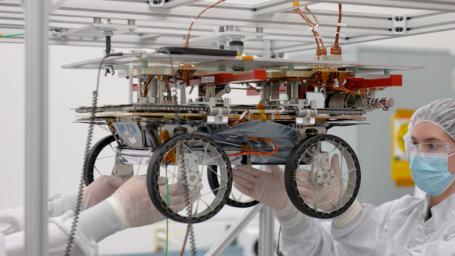Click here for video
Engineers tested the system that will lower three small rovers onto the lunar surface when NASA's CADRE (Cooperative Autonomous Distributed Robotic Exploration) technology demonstration arrives at the Moon aboard a lunar lander. The test took place in a clean room at NASA's Jet Propulsion Laboratory in Southern California in December 2023. Three deployer systems will be installed on the lander – one for each rover.
As the video begins, a release device makes a popping sound, signaling initiation of the deployment sequence. A flight model rover is then lowered from a fiber tether fed out by a motorized spool – part of the deployer assembly that will be attached to the lander. (In the test, a metal structure stands in for the lander.)
Since CADRE is designed to work in lunar gravity, the team must protect the tech demo's parts from being harmed during testing in Earth's gravity, which is approximately six times stronger than the Moon's. That's why JPL engineers Tonya Beatty and Kristopher Sherrill stand by in this video, ready to support the rover's weight as it is lowered. The team has also placed black plastic covers over the rover's ultralight aluminum wheels to prevent their grousers from catching on the clean room floor.
During this test, the tether lowers the rover slightly over 4 feet (1.3 meters), the distance the team expects the rovers to descend from the lander when on the Moon, though the deployer system can accommodate a shorter or longer distance. The deployer lowers the rovers at a rate of about 14 inches (36 centimeters) per minute. (The lowering sequence in the video has been sped up 20 times.) The rovers keep track of how much they rotate during their descent, and each rover will correct its position after its wheels touch down on the Moon.
Once on the surface, the rovers will detach from the tether, uncover their front and rear cameras, then drive away from the lander to a sunbathing spot where they can charge up their solar panels. They'll spend the daylight hours of a single lunar day – about 14 Earth days – doing experiments designed to demonstrate that multiple robots can cooperate and explore together autonomously.
This test marked the first time the project's flight sequence of commands was performed on the deployer system, showing the flight software can enable deployment.
JPL, a division of Caltech in Pasadena, California, manages CADRE for the Game Changing Development program within NASA's Space Technology Mission Directorate in Washington. The technology demonstration will launch as a payload on a lunar lander mission (IM-3) operated by Intuitive Machines under NASA's CLPS (Commercial Lunar Payload Services) initiative, which is managed by NASA's Science Mission Directorate, also in Washington. The agency's Glenn Research Center in Cleveland and its Ames Research Center in Silicon Valley, California, have both supported the project. Motiv Space Systems designed and built key hardware elements, including the deployers, at the company's Pasadena, California, facility. Clemson University in South Carolina contributed research in support of the project.

 Planetary Data System
Planetary Data System












